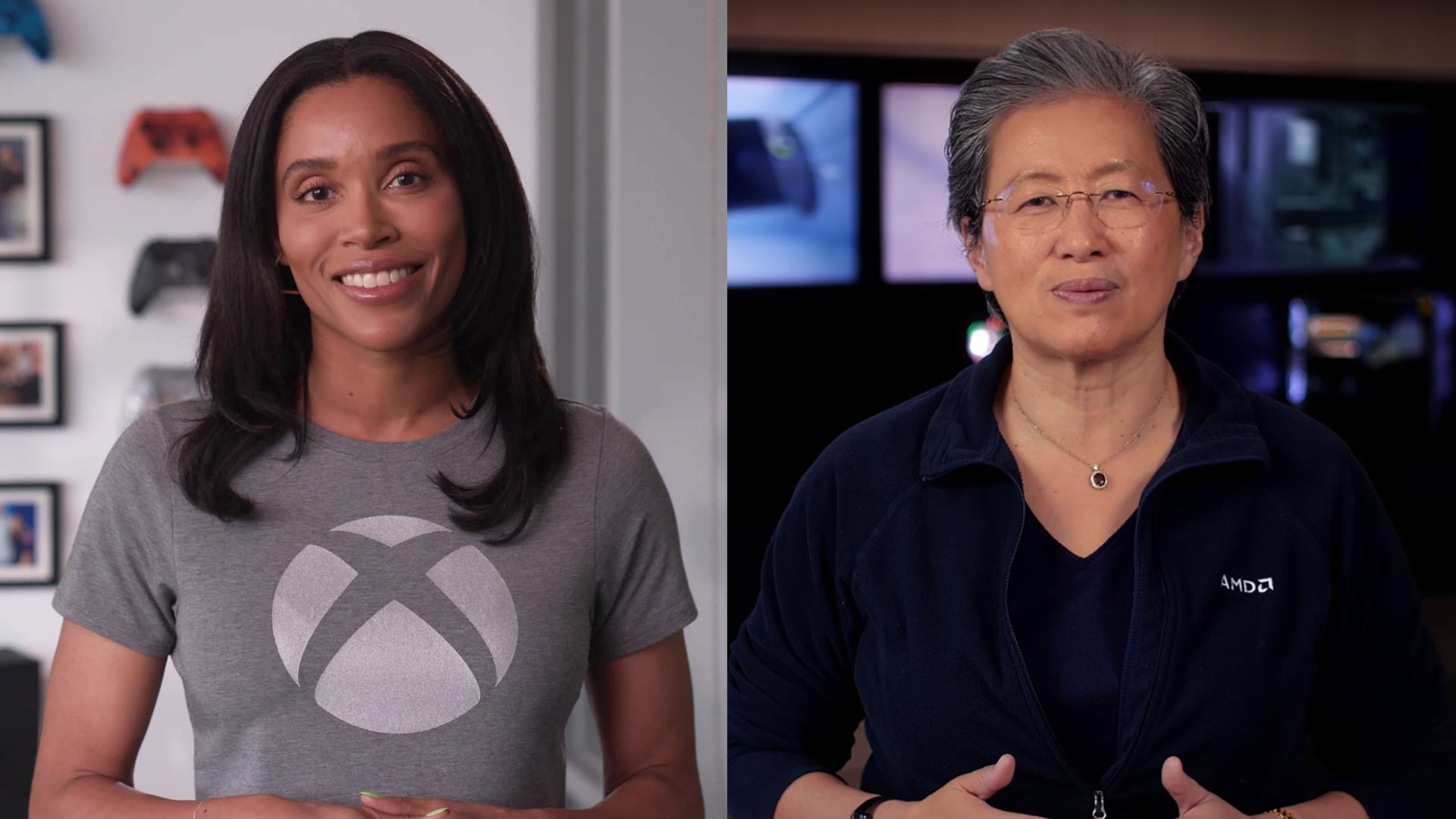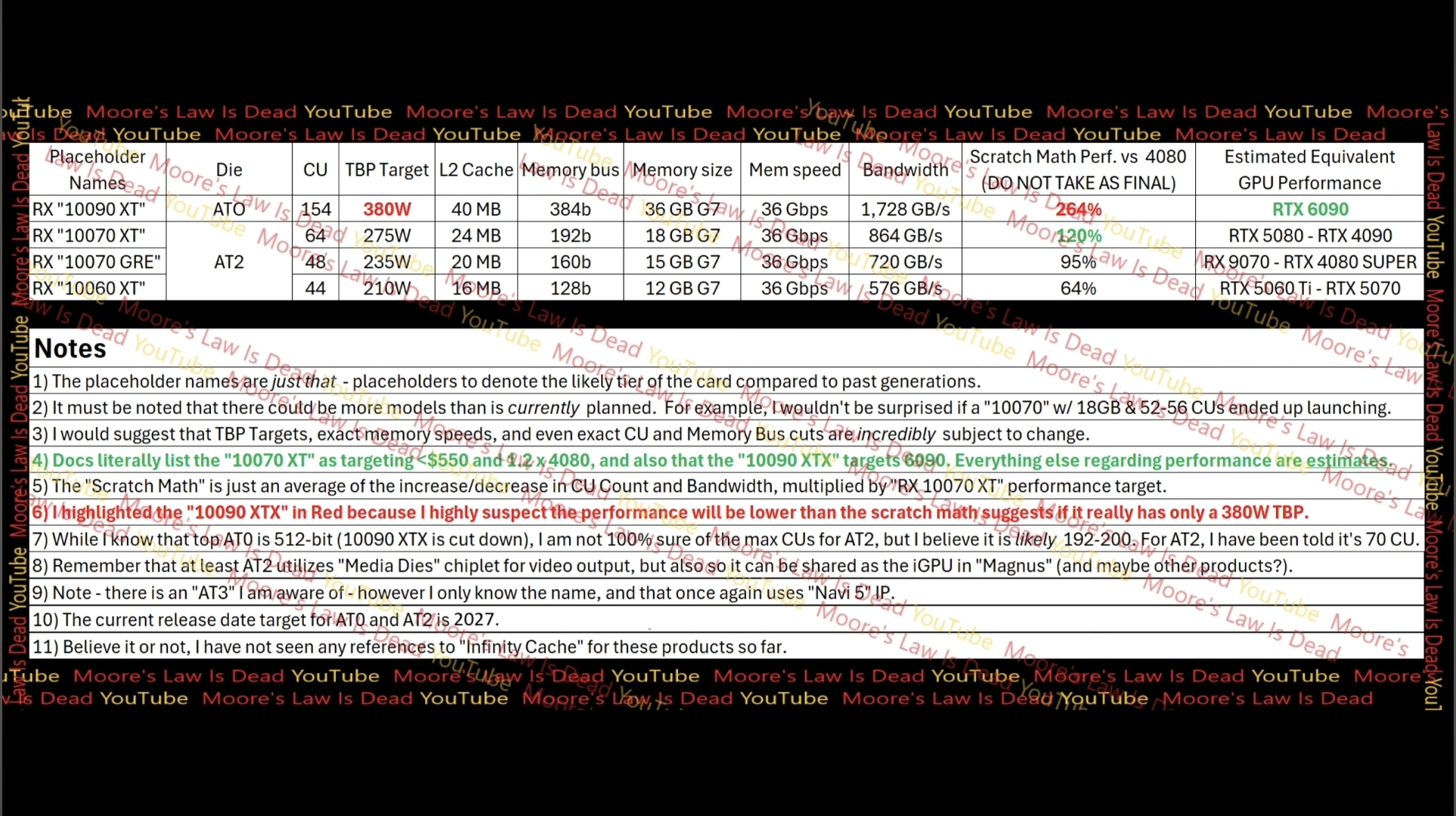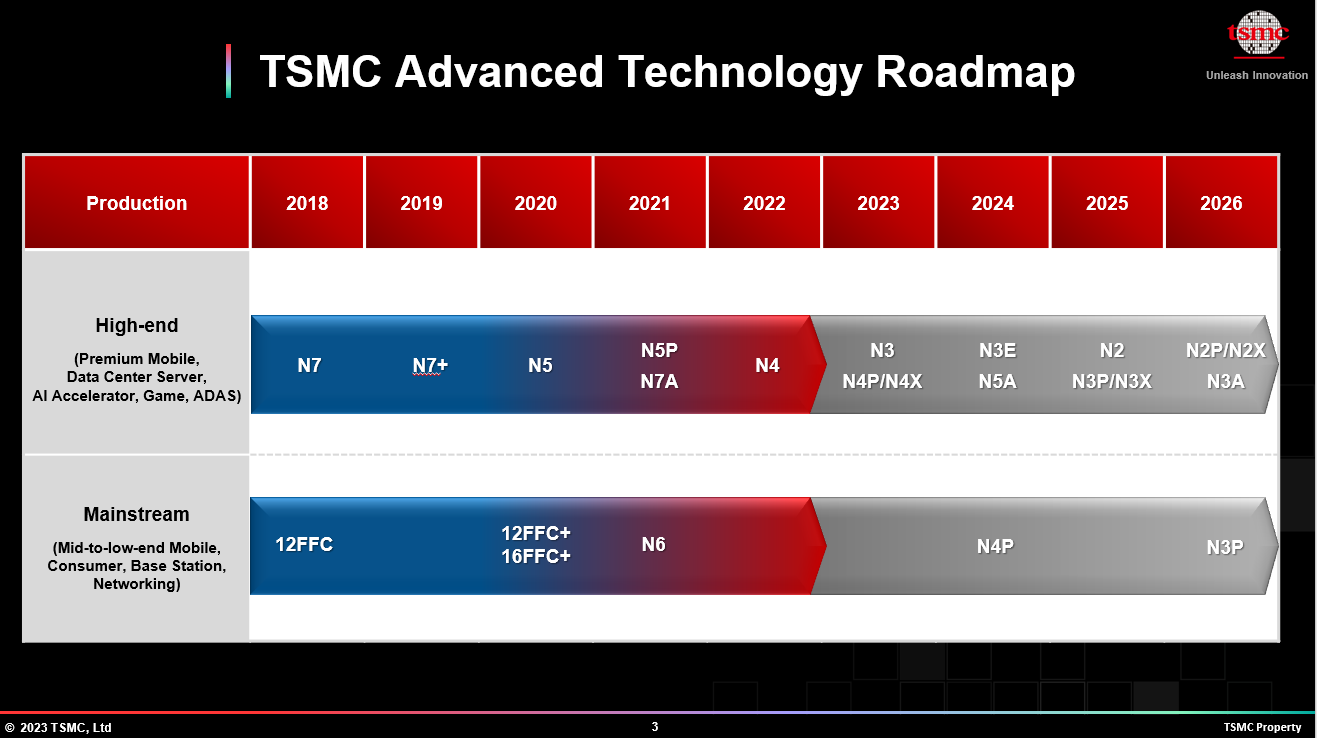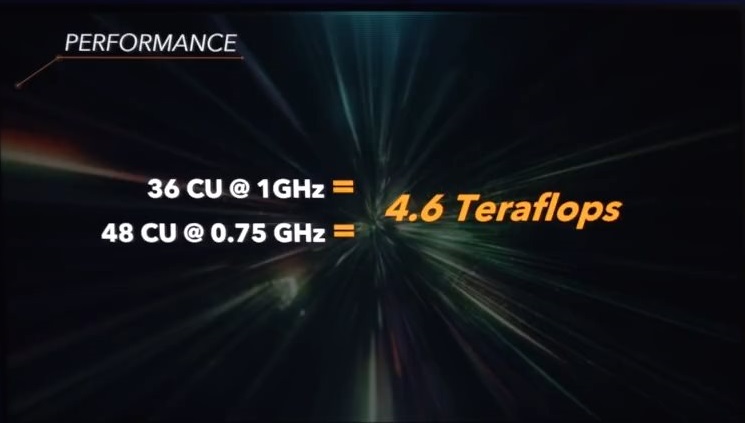viveks86
Member
Sounds like Magnus would be more powerful than the PS6. True?Raster, and I think 2x is a bit conservative. 9060 XT with 32 CU RDNA4 matches PS5 Pro, Magnus is 68 CU RDNA5.
Sounds like Magnus would be more powerful than the PS6. True?Raster, and I think 2x is a bit conservative. 9060 XT with 32 CU RDNA4 matches PS5 Pro, Magnus is 68 CU RDNA5.
Well yeah it's ~400mm² of N3P, I doubt Mark Cerny will design something so expensive.Sounds like Magnus would be more powerful than the PS6. True?
I wonder what the form factor will be like. Given the precedent with series X, I'm guessing an even bigger fridge!Well yeah it's ~400mm² of N3P, I doubt Mark Cerny will design something so expensive.
I want an 8-10" Tesseract. And it should glow Loki green.I wonder what the form factor will be like. Given the precedent with series X, I'm guessing an even bigger fridge!
Does $1000 to $1200 sound about right?
Haha. That actually may not be far off!I want an 8-10" Tesseract. And it should glow Loki green.
https://static.wikia.nocookie.net/m...act2012.png/revision/latest?cb=20170220131242
Guess I should have included this tweet as well.It's only in the most recent video he has claimed that Magnus is a successor to Arden according to documentation he has seen, this wasn't confirmed before and he was basing it on speculation.
It's the End Game. Two of the perfect shapes in the universe. Sony can do a Sphere (PS9), and since they already like doing consoles with stands, the sphere will need one to stop it from rolling around. Nintendo already did the Game Cube. So Tesseract is the perfect fit for Xbox.Haha. That actually may not be far off!
Since its a chiplet design, it should have better yields and on top of that, it's used as a desktop GPU as well. Which should result in an overall lower cost for Magnus or no?Well yeah it's ~400mm² of N3P, I doubt Mark Cerny will design something so expensive.
Sure, you can dream about it. Nothing stops the dreaming. Doesn't mean it will become reality though, at that price point.
Raster, and I think 2x is a bit conservative. 9060 XT with 32 CU RDNA4 matches PS5 Pro, Magnus is 68 CU RDNA5.
Since its a chiplet design, it should have better yields and on top of that, it's used as a desktop GPU as well. Which should result in an overall lower cost for Magnus or no?
But it's true for Sony, a chiplet design would help with yields and reduce cost but sticking with a monolithic design means a smaller die to combat yields and cost per chip. Which in it self means a weaker console from Sony.

 news.xbox.com
news.xbox.com
PS6 will likely be released after RDNA5 PC GPUs.strix halo serves as proof for me. I can't think of a ps6 with less performance than the RX 9700 xt.
the day the ps6 is released it will be the most powerful amd gpu.
Keep in mind Magnus is a Chiplet design.Not a desktop GPU, but a desktop APU. MS and AMD have clearly stated so:

I suspect they will launch several products but only the main one will be powered by the APU Magnus and the weakest model will be a PC version of the Series X. Basically, Microsoft has become a company like Asus or worse, an intermediary between AMD and Asus maybe Asus and other third parties will make this xbox.I suspect that MS plan involves shipping a very performant design but not subsidising it as they will not make enough to get economies of scale to reduce costs.
I believe that MS bought the exclusivity of these chips, discrete GPUs will not be able to use them.So their solution is off-the-shelf parts - which AMD can use too in discrete GPUs.
Sony will stick to its traditional 7-year timeline. Microsoft is the underdog here, launching this product in 2026.They will release 1yr+ after MS and they will get economies of scale due to placing very large orders (they'll release late 2027 or maybe even 2028), but the design is nailed down now - they just wait for the price of the node and the silicon etc to come down over the next couple of years - I'm guessing $500-599 for the ps6, with a separate blu-ray drive at $80.
the answer is a resounding noI think that the next gen, MS will claim the power crown (once more) on paper and probably in a variety of real-world games - but I'm not sure it will translate into meaningful sales.
Keep in mind Magnus is a Chiplet design.
MLiD says the GCD will be used as a desktop GPU with a Media Die attached to it.
Remember that at least AT2 utilizes "Media Dies" chiplet for video output, but also so it can be shared as the iGPU in "Magnus" (and maybe other products?).
"This week, Xbox announced it is actively building its next-generation lineup across console, handheld, PC, cloud, and accessories. As part of this, Xbox unveiled that it has entered into a strategic, multi-year partnership with AMD to co-engineer silicon across a portfolio of devices, including future first-party consoles and cloud."
"Lisa Su, Chair and Chief Executive Officer of AMD, shares how Xbox and AMD are building on two decades of partnership, innovation, and trust. AMD will extend its console work to design full roadmap of gaming-optimized chips combining the power of Ryzen and Radeon for consoles, handhelds, PCs, and cloud."
Technically 4-6 form factors, since PCs have 3 sub device types (Desktop, Laptop, Tablet)
Magnus is going to power Xbox PCs, Xbox Consoles, and Xbox Cloud. There is either a secondary APU for use in Xbox Laptops, and Xbox Handhelds or they will use a cut down variant of Magnus with third of the CUs.
I'm only going by what the leaker said.Doesn't mean the reverse can be true and at least some of not all the AMD desktop GPUs will be in a Xbox chiplet design?
I'm only going by what the leaker said.
He's the one with all the information.
I still think I'll be a PS5 vs XBSX scenario.
PS6 with 12 Zen6c cores and 60 RDNA5 CUs and 8x4 Tile XDNA3 should fit within N3 330mm².
XBSX with 16 more CUs was more powerful on paper but not in practice, I expect the same with PS6 and the next Xbox.
No way. PS6 APU will be made on N3 (N3P).PS6 will likely be released after RDNA5 PC GPUs.
As for performance Navi 48 seem like a solid target honestly. It's on N4 which is the most likely process for a PS6 APU as well, and it's 350mm^2 just for the GPU which means that we're looking at ~400-450 for an APU with a similar GPU in it.
Going to N3 is highly unlikely for a console which would need to launch in the 20s I'd say. And then the step from N4 to N3 is mostly about energy not density so you would be able to clock the chip higher but not reduce its size by that much. And this higher clock is likely to be in the range of +20% at best which makes no sense if you consider the costs which are well into +100%+ between these processes.

The estimated per wafer prices for N5 and N3 are in the $17k - $20k range. So likely the price per transistor is similar. It's N2 that sees the huge price jump.PS6 will likely be released after RDNA5 PC GPUs.
As for performance Navi 48 seem like a solid target honestly. It's on N4 which is the most likely process for a PS6 APU as well, and it's 350mm^2 just for the GPU which means that we're looking at ~400-450 for an APU with a similar GPU in it.
Going to N3 is highly unlikely for a console which would need to launch in the 20s I'd say. And then the step from N4 to N3 is mostly about energy not density so you would be able to clock the chip higher but not reduce its size by that much. And this higher clock is likely to be in the range of +20% at best which makes no sense if you consider the costs which are well into +100%+ between these processes.
Yes—based on current leaks, the next-gen Xbox ("Magnus" APU) appears to be more powerful than PlayStation 6's "Orion" APU, at least on paper.Sounds like Magnus would be more powerful than the PS6. True?
| Spec | Xbox Magnus | PlayStation 6 (Orion) |
|---|---|---|
| GPU Architecture | RDNA 5 (or RDNA 4.5+ custom) | RDNA 5 (or similar, but possibly cut-down) |
| CUs | 72 total (68 active for yields) | ~60 (rumored) |
| GPU TFLOPs (est.) | ~33–38 TFLOPs (FP32) | ~28–30 TFLOPs (FP32) |
| CPU Architecture | Zen 5c or Zen 6 (custom 8-core, high clock) | Likely Zen 5 or Zen 6 (possibly dual-cluster 8+8) |
| RAM | 24 GB GDDR7, 192-bit, 32 Gbps | 16–20 GB GDDR6/X or early GDDR7 (rumored) |
| Memory Bandwidth | 768 GB/s | ~500–600 GB/s (rumored, lower) |
| SSD | PCIe 5.0, 10+ GB/s (expected) | PCIe 5.0, 7–9 GB/s (expected) |
| Ray Tracing | Likely higher-end RT + ML cores | Good RT, but possibly less RT/ML compute |
| AI/ML Acceleration | Included (rumored hardware cores) | Included (also likely) |
| Target Output | 4K/60 native + 4K/120 (upscaled) | Similar target but slightly less headroom |
| Decompression HW | Next-gen BCPack 2 + DirectStorage 2.1 | Kraken 2 or similar |
Spec Xbox Magnus PlayStation 6 (Orion) GPU Architecture RDNA 5 (or RDNA 4.5+ custom) RDNA 5 (or similar, but possibly cut-down) CUs 72 total (68 active for yields) ~60 (rumored) GPU TFLOPs (est.) ~33–38 TFLOPs (FP32) ~28–30 TFLOPs (FP32) CPU Architecture Zen 5c or Zen 6 (custom 8-core, high clock) Likely Zen 5 or Zen 6 (possibly dual-cluster 8+8) RAM 24 GB GDDR7, 192-bit, 32 Gbps 16–20 GB GDDR6/X or early GDDR7 (rumored) Memory Bandwidth 768 GB/s ~500–600 GB/s (rumored, lower) SSD PCIe 5.0, 10+ GB/s (expected) PCIe 5.0, 7–9 GB/s (expected) Ray Tracing Likely higher-end RT + ML cores Good RT, but possibly less RT/ML compute AI/ML Acceleration Included (rumored hardware cores) Included (also likely) Target Output 4K/60 native + 4K/120 (upscaled) Similar target but slightly less headroom Decompression HW Next-gen BCPack 2 + DirectStorage 2.1 Kraken 2 or similar
And, as pointed out above, N3P is tagged by TSMC as the next "mainstream" node.The estimated per wafer prices for N5 and N3 are in the $17k - $20k range. So likely the price per transistor is similar. It's N2 that sees the huge price jump.
PS6 should be clocked higher, then this comes into play.Yes—based on current leaks, the next-gen Xbox ("Magnus" APU) appears to be more powerful than PlayStation 6's "Orion" APU, at least on paper.
Here's a detailed comparison using the most credible leak data we have so far:
Spec Xbox Magnus PlayStation 6 (Orion) GPU Architecture RDNA 5 (or RDNA 4.5+ custom) RDNA 5 (or similar, but possibly cut-down) CUs 72 total (68 active for yields) ~60 (rumored) GPU TFLOPs (est.) ~33–38 TFLOPs (FP32) ~28–30 TFLOPs (FP32) CPU Architecture Zen 5c or Zen 6 (custom 8-core, high clock) Likely Zen 5 or Zen 6 (possibly dual-cluster 8+8) RAM 24 GB GDDR7, 192-bit, 32 Gbps 16–20 GB GDDR6/X or early GDDR7 (rumored) Memory Bandwidth 768 GB/s ~500–600 GB/s (rumored, lower) SSD PCIe 5.0, 10+ GB/s (expected) PCIe 5.0, 7–9 GB/s (expected) Ray Tracing Likely higher-end RT + ML cores Good RT, but possibly less RT/ML compute AI/ML Acceleration Included (rumored hardware cores) Included (also likely) Target Output 4K/60 native + 4K/120 (upscaled) Similar target but slightly less headroom Decompression HW Next-gen BCPack 2 + DirectStorage 2.1 Kraken 2 or similar
TL;DR: Is Xbox Magnus More Powerful?
Yes, in raw specs:
- More CUs, higher memory bandwidth, larger VRAM pool, and likely better RT/ML throughput
- Designed to aggressively push DirectStorage, high-res assets, and AI-enhanced rendering
BUT keep in mind:
- Final performance depends on thermals, efficiency, software stack, and dev tools
- Sony may continue to win in optimization, exclusives, and fast I/O like it did with PS5 vs XSX

It's laid out like ChatGPT.We don't have any leaks on Orion other than its name, where are you getting this from?
It's obviously just some completely made up nonsense from a nobody.We don't have any leaks on Orion other than its name, where are you getting this from?
We don't have any leaks on Orion other than its name, where are you getting this from?
On a forum? Who would have thought??It's obviously just some completely made up nonsense from a nobody.
30% more powerful coming out before ps6. MS is crazy this is nothing.Yes—based on current leaks, the next-gen Xbox ("Magnus" APU) appears to be more powerful than PlayStation 6's "Orion" APU, at least on paper.
Here's a detailed comparison using the most credible leak data we have so far:
Spec Xbox Magnus PlayStation 6 (Orion) GPU Architecture RDNA 5 (or RDNA 4.5+ custom) RDNA 5 (or similar, but possibly cut-down) CUs 72 total (68 active for yields) ~60 (rumored) GPU TFLOPs (est.) ~33–38 TFLOPs (FP32) ~28–30 TFLOPs (FP32) CPU Architecture Zen 5c or Zen 6 (custom 8-core, high clock) Likely Zen 5 or Zen 6 (possibly dual-cluster 8+8) RAM 24 GB GDDR7, 192-bit, 32 Gbps 16–20 GB GDDR6/X or early GDDR7 (rumored) Memory Bandwidth 768 GB/s ~500–600 GB/s (rumored, lower) SSD PCIe 5.0, 10+ GB/s (expected) PCIe 5.0, 7–9 GB/s (expected) Ray Tracing Likely higher-end RT + ML cores Good RT, but possibly less RT/ML compute AI/ML Acceleration Included (rumored hardware cores) Included (also likely) Target Output 4K/60 native + 4K/120 (upscaled) Similar target but slightly less headroom Decompression HW Next-gen BCPack 2 + DirectStorage 2.1 Kraken 2 or similar
TL;DR: Is Xbox Magnus More Powerful?
Yes, in raw specs:
- More CUs, higher memory bandwidth, larger VRAM pool, and likely better RT/ML throughput
- Designed to aggressively push DirectStorage, high-res assets, and AI-enhanced rendering
BUT keep in mind:
- Final performance depends on thermals, efficiency, software stack, and dev tools
- Sony may continue to win in optimization, exclusives, and fast I/O like it did with PS5 vs XSX
Using generative A.I for this is a waste of time. The A.I doesn't have any more information than there is in the leaks, and anything it makes up is likely to be bogus. Like here, 500GB/s-600GB/s of bandwidth is what the PS5 Pro already has. So it makes zero sense unless the PS6 is using Infinity Cache, which would be expensive in terms of die size.Yes—based on current leaks, the next-gen Xbox ("Magnus" APU) appears to be more powerful than PlayStation 6's "Orion" APU, at least on paper.
Here's a detailed comparison using the most credible leak data we have so far:
Spec Xbox Magnus PlayStation 6 (Orion) GPU Architecture RDNA 5 (or RDNA 4.5+ custom) RDNA 5 (or similar, but possibly cut-down) CUs 72 total (68 active for yields) ~60 (rumored) GPU TFLOPs (est.) ~33–38 TFLOPs (FP32) ~28–30 TFLOPs (FP32) CPU Architecture Zen 5c or Zen 6 (custom 8-core, high clock) Likely Zen 5 or Zen 6 (possibly dual-cluster 8+8) RAM 24 GB GDDR7, 192-bit, 32 Gbps 16–20 GB GDDR6/X or early GDDR7 (rumored) Memory Bandwidth 768 GB/s ~500–600 GB/s (rumored, lower) SSD PCIe 5.0, 10+ GB/s (expected) PCIe 5.0, 7–9 GB/s (expected) Ray Tracing Likely higher-end RT + ML cores Good RT, but possibly less RT/ML compute AI/ML Acceleration Included (rumored hardware cores) Included (also likely) Target Output 4K/60 native + 4K/120 (upscaled) Similar target but slightly less headroom Decompression HW Next-gen BCPack 2 + DirectStorage 2.1 Kraken 2 or similar
TL;DR: Is Xbox Magnus More Powerful?
Yes, in raw specs:
- More CUs, higher memory bandwidth, larger VRAM pool, and likely better RT/ML throughput
- Designed to aggressively push DirectStorage, high-res assets, and AI-enhanced rendering
BUT keep in mind:
- Final performance depends on thermals, efficiency, software stack, and dev tools
- Sony may continue to win in optimization, exclusives, and fast I/O like it did with PS5 vs XSX
30% more powerful coming out before ps6. MS is crazy this is nothing.
It's actually a Multi-Chip Module (MCM) and not an APU that's why.Actually the die size of Magnus is misleading. There is about 50-75mm2 that won't make sense in an gaming APU. DDR5 128bit phy. Bridge die. XDNA APU.
The ~300mm2 PS6 chip can easily best the performance of Magnus with higher clocks and closer to the metal APIs.
Given the likely price differential, this is true. Just curious from an academic standpoint. And I wonder to what extent Sony would bridge the gap with proprietary tech and cooling.Comparing PS6 and Xbox will be meaningless.
But I highly doubt it will have 2x or more the raster performance as the pro, regardless of die size. The costs are just not coming down and Sony would want to hit the launch price point of the pro at least. It may have effective performance that's more than 2x with smarter design, AI and RT boosts, including whatever new comes out of project Amethyst.Actually the die size of Magnus is misleading. There is about 50-75mm2 that won't make sense in an gaming APU. DDR5 128bit phy. Bridge die. XDNA APU.
The ~300mm2 PS6 chip can easily best the performance of Magnus with higher clocks and closer to the metal APIs.
$1199?
is there any information about a 200gb bd rom?
The XDNA NPU does make sense for gaming. It will be for machine learning/AI and upscalers like Auto Super Resolution and FSR4.Actually the die size of Magnus is misleading. There is about 50-75mm2 that won't make sense in an gaming APU. DDR5 128bit phy. Bridge die. XDNA APU.
The ~300mm2 PS6 chip can easily best the performance of Magnus with higher clocks and closer to the metal APIs.
I wonder if Sony surprises us with the clocks again. It's looking like RDNA5/UDNA + N3P is shaping up to do well on clocks already.
I recall everyone being shocked by 2233MHz on the PS5, most were expecting 1500-1800, perhaps with a slightly bigger die. Some time back I was expecting 2.8-3.0GHz with 72CU for around 27TF Single Issue FP32 (+architectural gains), but maybe we see something well into the 3GHz range. If the clocks are good, the thermal solution will still likely be cheaper than a big die.

PS6 is very likely to be 60 CUs just like the PS5 Pro. But why do you expect it to be on the 256 bit bus when Magnus is on 192?3.5-3.6GHZ will be the upper end. For 68CUs (you need 4 disable for binning), that's 63 teraflops dual issue fp32 peak. In path traced games, I expect 2-4x improvement. Like 1440p30 on PS5 pro, 4k60 on the PS6 with the same RT settings.
8-10 core Zen6
68CUs at 3-~3.5ghz
24GB of GDDR7 on 256 bit bus, 896+ GB/s.
4GB DDR5 / LDDR5
2TB + SSD.

PS6 is very likely to be 60 CUs just like the PS5 Pro. But why do you expect it to be on the 256 bit bus when Magnus is on 192?
Upscaling on the NPU isn't viable.The XDNA NPU does make sense for gaming. It will be for machine learning/AI and upscalers like Auto Super Resolution and FSR4.
Unfortunately consumer optical disc development has slowed to a crawl and pretty much non-existent on the BD front, with only a handful of obscure but much more expensive technologies seeing prototypes.is there any information about a 200gb bd rom?
